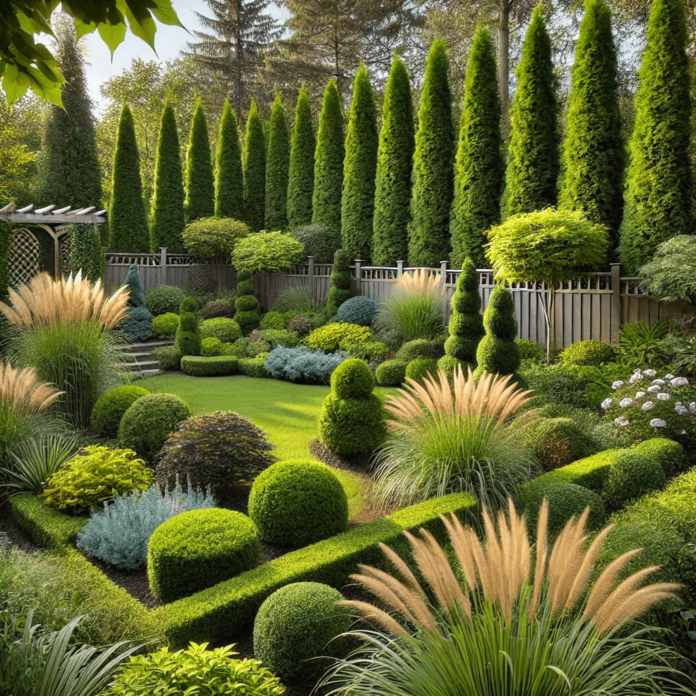Introduction
Privacy landscaping is a natural way to create a secluded, peaceful space in your yard. Using the best plants for privacy, like evergreens, shrubs, and ornamental grasses, you can design lush barriers that enhance both beauty and privacy. By choosing the right plants and arranging them effectively, private landscaping can shield your yard from view, reduce noise, and create a serene outdoor environment. Whether you’re looking for a simple hedge or a layered green wall, here’s a guide to the best plants and layouts to achieve a private and tranquil yard.
Top Privacy Landscaping Ideas for a Secluded Yard

Privacy landscaping is an ideal solution to create a private retreat within your yard, using natural elements to enhance seclusion. Start by selecting a combination of evergreen trees, dense shrubs, and ornamental grasses for year-round coverage. For example, tall evergreens like arborvitae or cedar form a natural fence that blocks views and absorbs noise, while flowering shrubs like viburnum add color and seasonal interest. Layering plants of varying heights adds depth and provides a solid privacy barrier that looks both natural and inviting.
Choosing the Right Plants for Privacy
Selecting the right plants for privacy is essential to creating an effective and natural barrier. The following options are some of the best plants to consider for privacy landscaping:
Evergreens
Evergreens are popular for privacy because they retain their foliage year-round, providing consistent coverage. Varieties such as arborvitae, cypress, and pine are great for forming dense green walls. Arborvitae, in particular, is a fast-growing evergreen that can reach impressive heights, making it ideal for taller privacy screens. Planting evergreens in a row provides a classic, uniform look that’s perfect for blocking out noise and neighbors.
Shrubs and Hedges
Shrubs and hedges are another versatile choice for privacy landscaping. Boxwood, yew, and privet are common hedging plants that can be pruned into a formal shape or left to grow naturally. Boxwoods, for instance, are dense and grow well in a variety of climates, making them an excellent choice for both privacy and decorative value. Planting shrubs close together creates a thick, impenetrable barrier that can serve as a fence replacement in many yards.
Ornamental Grasses
Ornamental grasses, like bamboo, fountain grass, and switchgrass, are excellent for creating a softer, natural-looking privacy screen. Bamboo, especially, is known for its rapid growth and can create a tall privacy wall in a short time. It’s best to choose clumping varieties of bamboo, as they are less invasive than spreading types. Ornamental grasses are especially effective when used in layered plantings, as they add height and texture without blocking light completely.
Designing Effective Privacy Layouts
Creating a privacy-focused landscape involves more than just selecting plants; you also need to plan the layout strategically to achieve maximum coverage and aesthetic appeal. Here are some layout techniques for a private and stylish yard:
- Layered Planting Techniques: Using multiple layers of plants at different heights creates a dense, natural barrier. For example, start with taller trees or shrubs in the back, followed by mid-sized plants, and finally, shorter plants or grasses in the front. This layered approach not only enhances privacy but also adds depth and visual interest to your landscape.
- Staggered Arrangements for Maximum Coverage: Rather than planting everything in a straight line, stagger your plants for fuller coverage. Staggered rows help to close any gaps, making it more difficult for outsiders to see into your yard.
- Integrating Privacy Screens and Trellises: While plants provide natural privacy, combining them with hardscaping elements like privacy screens or trellises can enhance their effectiveness. For example, you can place a trellis with climbing plants near a patio or use a decorative privacy screen as a focal point in the garden. These elements are especially useful for small spaces where full-sized trees and shrubs may not fit.
Popular Privacy Plants for Different Climates
To ensure your plants thrive, it’s important to choose varieties suited to your climate. Here are some top privacy plant picks based on climate conditions:
- Warm Climates: In warmer regions, consider fast-growing plants like bamboo, oleander, and wax myrtle. These species are heat-tolerant and thrive with plenty of sunlight, making them ideal for areas with long, hot summers.
- Cold Climates: For colder climates, hardy evergreens like spruce, juniper, and hemlock provide year-round coverage and withstand harsh winters. Boxwoods and holly shrubs also tolerate cold well and can be shaped into compact hedges for smaller spaces.
Selecting climate-appropriate plants is essential to reduce maintenance and ensure that your privacy plants grow healthily.
DIY Privacy Landscaping Tips
If you’re tackling a privacy landscaping project on your own, keep these tips in mind for the best results:
- Spacing and Placement: Avoid crowding your plants by giving them enough space to grow. Overcrowding can lead to unhealthy plants and may create gaps in coverage. Each plant species has specific spacing needs, so consult planting guides for accurate measurements.
- Regular Maintenance: Privacy plants need regular care to stay dense and healthy. Prune shrubs and hedges periodically to encourage growth, and trim evergreens as needed to maintain a tidy appearance. Bamboo and fast-growing grasses may require more frequent maintenance to prevent them from becoming invasive.
- Combining Hardscapes with Plants for Privacy: Using hardscapes such as stone walls, fences, or pergolas alongside plants can create an effective privacy solution that’s both durable and beautiful. Hardscapes provide structure and stability, while plants add natural beauty and flexibility to the design.
Combining these techniques allows you to create a well-balanced landscape that provides the desired privacy while enhancing your yard’s natural beauty.
Conclusion
Landscaping for privacy not only creates a secluded, peaceful space but also adds to the value and enjoyment of your property. From lush hedges and evergreens to graceful grasses and climbing vines, there are numerous plants and layout techniques to achieve your privacy goals. By choosing the right plants for your climate and following a well-thought-out layout, you can design a landscape that shields your yard beautifully. With a bit of planning and regular maintenance, your outdoor space can become a private oasis, perfect for relaxing, entertaining, and enjoying nature year-round.














